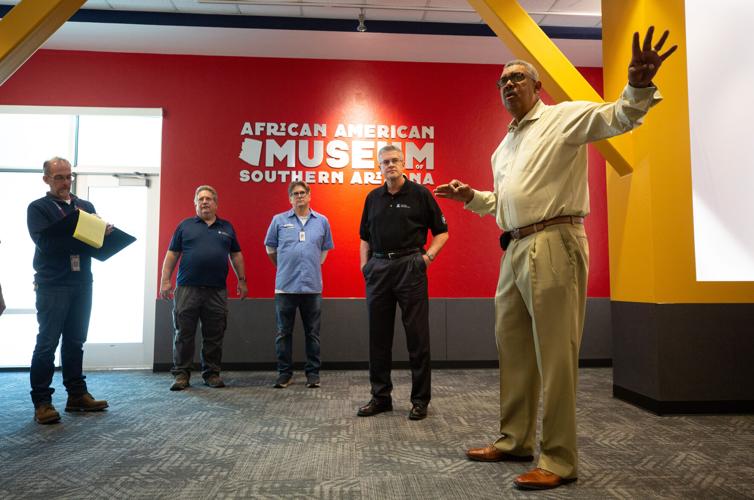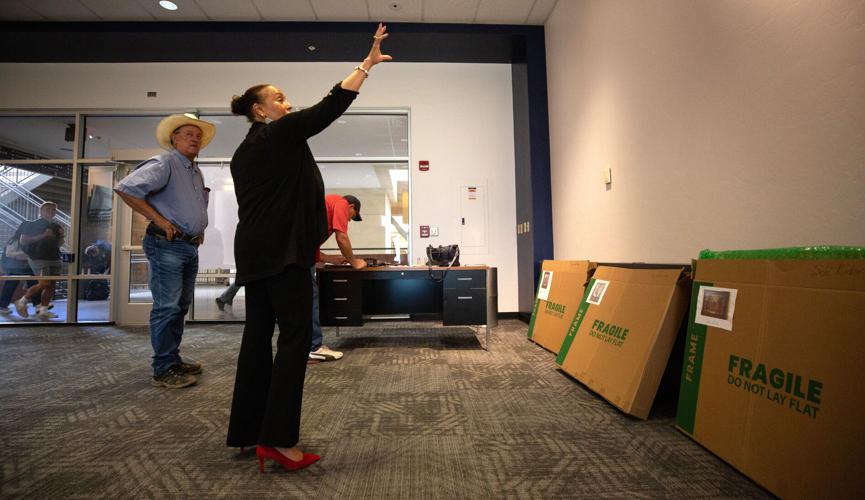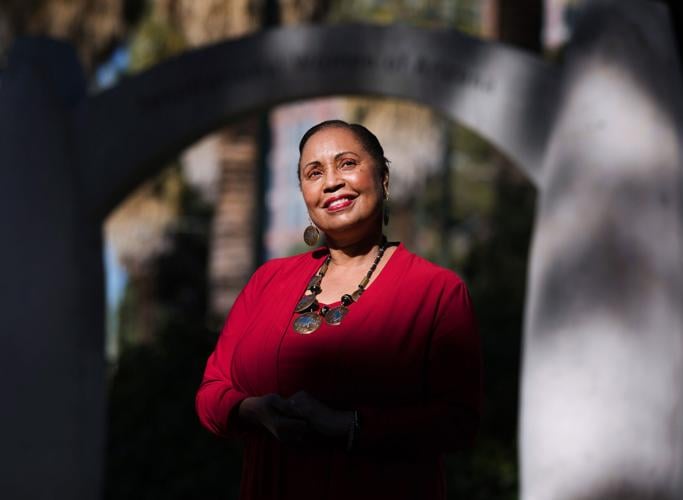The African American Museum of Southern Arizona will make the jump from the web to the real world this month, with its first physical exhibits and a guest speaker so iconic that Norman Rockwell once painted her.
On Nov. 17, the museum will welcome Ruby Bridges to Tucson for a fireside chat about her life as a civil rights advocate, starting at the age of 6, when she was the first Black child to attend the all-white William Frantz Elementary School in New Orleans on Nov. 14, 1960.
Within a day or two of Bridges’ visit, the museum hopes to unveil a new gallery of displays inside the student union at the University of Arizona.
“That’s our goal,” said Beverely Elliott, the museum’s co-founder and executive director.

Beverely Elliott, one of the African American Museum of Southern Arizona founders, talks with UA facilities management staff about placement of historical paintings at the museum inside the University of Arizona Student Union.
Initial offerings will include exhibits on the Buffalo Soldiers in Arizona, pioneering UA men’s basketball coach Fred Snowden, the quilting tradition and the CROWN Act, a growing movement to outlaw race-based hair discrimination in the workplace.
Video displays will show clips about Arizona history, interviews with prominent Tucsonans and legacy stories about people from generations past.
The exhibits will be housed in room 244 of the student union, next door to the USS Arizona memorial museum.
Elliott said they are also planning seasonal “pop-up” displays on Kwanzaa, Martin Luther King Jr. and other topics.

Beverely Elliott is leading an effort to establish the African American Museum of Southern Arizona at the University of Arizona. The museum is dedicated to Black history in the area.
An icon at 6
Eventually, Elliott and company hope to trade the 1,100-square-foot space at the student union for a larger, permanent facility planned elsewhere on campus in partnership with the UA Foundation.
The museum was launched online on Dec. 31, and its virtual collection of interviews, tributes and historical information and photographs has been growing ever since.
Organizers originally hoped to open in the student union in the spring, but Elliott said work on the space was delayed by supply-chain problems and lingering complications from the COVID-19 pandemic.

U.S. Deputy Marshals escort 6-year-old Ruby Bridges from William Frantz Elementary School in New Orleans in November 1960.
Bridges is scheduled to speak at 6 p.m. Nov. 17 in the auditorium at Palo Verde High Magnet School before an audience of about 300 students, parents and others.
Elliott said the event is already sold out, as is the VIP reception with the civil rights icon before her conversation on equality. The fireside chat — minus an actual fire — will be emceed by Elliott’s husband, UA Sports Hall of Famer Bob Elliott (basketball), who helped arrange Bridges' visit after meeting her in February at a speaking engagement hosted by AAA.
Now 68, Bridges has been known around the world since the first grade, when news photographers captured the tiny girl with a flower in her hair being escorted from school by federal marshals.
The image inspired Rockwell to paint “The Problem We All Live With,” which depicts Bridges walking tall past a wall stained with racist graffiti and smashed tomatoes.
Bridges would go on to write several books about her experiences, start a foundation dedicated to equality and tour the country as a paid public speaker.
In 2011, she met with then-President Barack Obama at the White House, where he had Rockwell’s 1964 painting hung in a hallway outside the Oval Office.

Ruby Bridges visited the White House, joining then-President Barack Obama to view Norman Rockwell’s famous painting, “The Problem We All Live With,” which depicts Ruby as she is escorted to school on the court-ordered first day of integrated schools in New Orleans in 1960.
Ruby's walk
Three days before she arrives in Tucson, Bridges will be celebrated at schools in Tucson and elsewhere with Ruby Bridges Walk to School Day.
Elliott said the event on Nov. 14 — the 62nd anniversary of Bridges’ famous first day of class — will include history lessons, inter-generational conversations and a ceremonial walk around campus.
For safety reasons, Elliott said, most students here won’t be walking to school that day as they do in California, where the annual event first began in 2018.
AAA, formerly known as the American Automobile Association, is involved with the walk as well. The association’s Mountain West Group is offering a number of resources to schools in Arizona and elsewhere in the region, including grants of up to $1,000 to help fund walk-day activities, free pre-printed event materials and downloadable lesson plans about Bridges’ story.
Bridges has said she wants the annual walk events to serve as “a day of dialogue” about what she had to go through back then and what challenges kids still face to go to school today, Elliott said. Both Pima County and the city of Tucson have signed proclamations declaring Nov. 14 Ruby Bridges Walk To School Day.

Bill Florence of UA facilities management fastens a sign to the window frame of the African American Museum of Southern Arizona inside the University of Arizona Student Union.
The Nov. 17 fireside chat will double as a fundraiser for the African American Museum of Southern Arizona. Elliott said several major sponsors have stepped up to cover the cost of Bridges’ visit and help the fledgling museum, including AAA, the United Way, TEP, Cox Communications and the UA Foundation. The Arizona Daily Star has also contributed.
More special events are now in the works, including one highlighting prominent local musicians and another in February featuring Fred Snowden’s daughter, Stacey, who will reminisce about her dad and debut clips from an upcoming documentary she is producing about the groundbreaking Black coach.
Elliott said people can keep track of what’s coming up on the museum’s ever-expanding website at www.aamsaz.org.
“It’s just been the most amazing journey so far,” she said. “We’ve had such an outpouring of love and people telling us this is something our community needs. It’s been such a validation that we’re moving in the right direction.”
David Fitzsimmons chats with Beverely Elliott, Executive Director of the African American Museum of Southern Arizona all about the need for the Museum in Tucson, what they will offer and how you can become a member.










